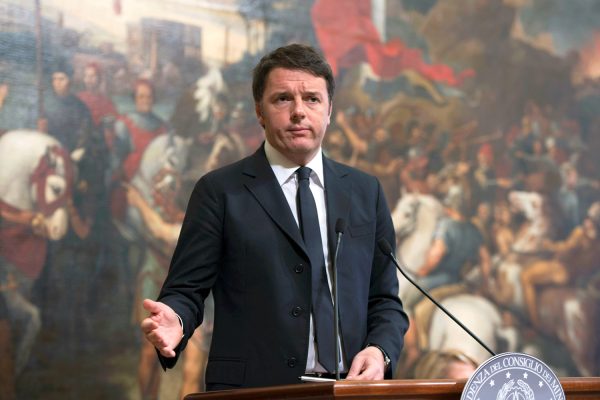
Former Italian prime minister Matteo Renzi has pulled the plug on the country’s ruling center-left coalition.
Renzi, now a senator, has withdrawn his 48 lawmakers and three ministers (one junior) from the coalition ostensibly over a spending dispute. He wants to use Italy’s €200+ billion share of the European Union’s €750 billion coronavirus recovery fund to invest in infrastructure and the green economy. The other ruling parties prefer to use the bulk of the money for short-term stimulus.
Renzi has also proposed to tap into the European Stability Mechanism (ESM), set up in the wake of the euro crisis, to help pay for Italy’s increased health-care spending, something Prime Minister Giuseppe Conte has resisted. ESM funding would come with strings attached. Countries are free to spend their share of the coronavirus recovery fund however they see fit.
Renzi’s proposals have merit. Italy is failing its next generation. It needs structural reforms — which ESM support would require — to catch up with the rest of Europe. Spending €200 billion to prop up the Italian economy in the short term is a wasted opportunity.
But expecting the other ruling parties to meet his terms, when Renzi’s is by far the smallest of the three, is unreasonable. Throwing Italy into a political crisis when it is still suffering one of the worst outbreaks of coronavirus disease in the world is irresponsible.
Conte must now find a new majority in parliament, perhaps with members of former prime minister Silvio Berlusconi’s Forza Italia, or call early elections.
Labor reforms
This is not unusual behavior for Renzi. He has a tendency to ruin good causes by making them all about himself.
When he came to power in 2014, Renzi, then the head of the Democratic Party, rightly focused on liberalizing Italy’s sclerotic labor market. He stared down opposition from trade unions and the left of his party to make it easier for companies to hire and fire workers, and to give them more flexibility between hiring workers either full-time on ironclad contracts or on zero-hours contracts without social benefits.
In a concession to the unions and the left, Renzi applied the reforms only to new hires, not anyone in work. That undermined their effectiveness. Unemployment fell, but only by a few points. Middle-aged and well-educated Italians remained almost impossible to lay off. Younger and undereducated Italians still struggled to find work.
EU fights
Rather than double down and find other ways to cut unemployment, for example by relaxing licensing requirements or boosting Italy’s low tertiary education rate (27 percent compared to an EU average of 40 percent), Renzi announced his work was done and — like so many Italian prime ministers before him — demanded more “flexibility” from the EU in implementing its budget rules and economic policy recommendations. (Which Italy has consistently ignored.)
He picked a fight with the European Commission over his spending plan, which resulted in only minor modifications. He singlehandedly delayed sanctions on Russia to chastise Germany for its participation in Nord Stream 2 — which pipes Russian gas directly into Germany via the Baltic Sea, bypassing Ukraine — only to stab Eastern Europe in the back as soon as Italy was promised a role in the project! (Nothing came of it.)
Referendum
Renzi devoted the remainder of his term to political reforms. He proposed to weaken the Senate, then as now an elected body with equal lawmaking powers to the lower house, and give the top vote-getter in elections extra seats in the lower chamber to make it easier to form coalition governments.
When opposition to the proposals mounted, Renzi unwisely tied his fate to the outcome of a referendum about the changes, daring Italians to vote them down. Predictably, this made the referendum about him, and the same 60 percent of Italians who voted for other parties in the 2014 election voted against Renzi in the 2016 referendum. He resigned later that year.
Legacy
Renzi’s legacy was diminished when Conte overturned his labor reforms in 2018 with the support of the far right.
Renzi left the Democratic Party the following year to start Italia Viva, which has remained a splinter party.
Renzi thought he could become Italy’s Tony Blair or Italy’s Emmanuel Macron, but he is yesterday’s news. He needs to stop sabotaging his successors and move on.
